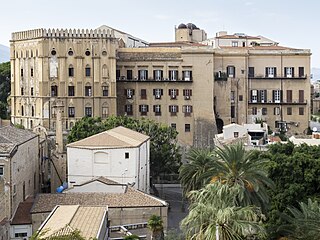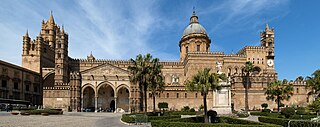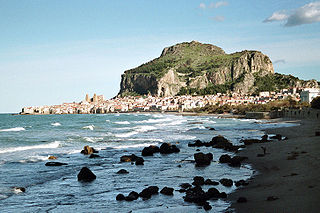
Palermo is a city in southern Italy, the capital of both the autonomous region of Sicily and the Metropolitan City of Palermo, the city's surrounding metropolitan province. The city is noted for its history, culture, architecture and gastronomy, playing an important role throughout much of its existence; it is over 2,700 years old. Palermo is in the northwest of the island of Sicily, by the Gulf of Palermo in the Tyrrhenian Sea.

Monreale is a town and comune in the Metropolitan City of Palermo, in Sicily, Southern Italy. It is located on the slope of Monte Caputo, overlooking the very fertile valley called "La Conca d'oro", a production area of orange, olive and almond trees, the produce of which is exported in large quantities. The town, which has a population of approximately 39,000, is about 7 kilometres inland (south) of Palermo, the regional capital.

The term Norman architecture is used to categorise styles of Romanesque architecture developed by the Normans in the various lands under their dominion or influence in the 11th and 12th centuries. In particular the term is traditionally used for English Romanesque architecture. The Normans introduced large numbers of castles and fortifications including Norman keeps, and at the same time monasteries, abbeys, churches and cathedrals, in a style characterised by the usual Romanesque rounded arches and especially massive proportions compared to other regional variations of the style.

The Church of San Cataldo is a Catholic church located at Piazza Bellini, in central Palermo, Sicily, Italy. Erected in 1154 as a notable example of the Arab-Norman architecture which flourished in Sicily under Norman rule on the island, the church is annexed to that of Santa Maria dell'Ammiraglio. Since the 1930s, it belongs to the Order of the Holy Sepulchre.

The Zisa is a grand 12th-century Norman hunting lodge and summer palace in the western area of Palermo, in the region of Sicily, Italy. The edifice was started around 1165 by Arab craftsmen under the rule of the Norman conqueror of Sicily, king William I. It was not finished until 1189, under the rule of William II. It is presently open to the public for tours.

The Palazzo dei Normanni is also called Royal Palace of Palermo. It was the seat of the Kings of Sicily with the Hauteville dynasty and served afterwards as the main seat of power for the subsequent rulers of Sicily. Since 1946 it has been the seat of the Sicilian Regional Assembly. The building is the oldest royal residence in Europe; and was the private residence of the rulers of the Kingdom of Sicily and the imperial seat of Frederick II and Conrad IV.

Monreale Cathedral is a Catholic church in Monreale, Metropolitan City of Palermo, Sicily. One of the greatest existent examples of Norman architecture, it was begun in 1174 by William II of Sicily. In 1182 the church, dedicated to the Nativity of the Virgin Mary, was, by a bull of Pope Lucius III, elevated to the rank of a metropolitan cathedral as the seat of the diocese of Monreale, which was elevated to the Archdiocese of Monreale in 1183. Since 2015 it has been part of the Arab-Norman Palermo and the Cathedral Churches of Cefalù and Monreale UNESCO World Heritage Site.

Palermo Cathedral is the cathedral church of the Roman Catholic Archdiocese of Palermo, located in Palermo, Sicily, southern Italy. It is dedicated to the Assumption of the Virgin Mary. As an architectural complex, it is characterized by the presence of different styles, due to a long history of additions, alterations and restorations, the last of which occurred in the 18th century.

The Church of St. Mary of the Admiral, also called Martorana, is the seat of the Parish of San Nicolò dei Greci, overlooking the Piazza Bellini, next to the Norman church of San Cataldo and facing the Baroque church of Santa Caterina, in Palermo, Italy.

The Cathedral of Cefalù is a Roman Catholic basilica in Cefalù, Sicily. It is one of nine structures included in the UNESCO World Heritage Site known as Arab-Norman Palermo and the Cathedral Churches of Cefalù and Monreale.

The term Norman–Arab–Byzantine culture, Norman–Sicilian culture or, less inclusively, Norman–Arab culture, refers to the interaction of the Norman, Byzantine Greek, Latin, and Arab cultures following the Norman conquest of the former Emirate of Sicily and North Africa from 1061 to around 1250. The civilization resulted from numerous exchanges in the cultural and scientific fields, based on the tolerance shown by the Normans towards the Latin- and Greek-speaking Christian populations and the former Arab Muslim settlers. As a result, Sicily under the Normans became a crossroad for the interaction between the Norman and Latin Catholic, Byzantine–Orthodox, and Arab–Islamic cultures.

Cefalù, classically known as Cephaloedium, is a city and comune in the Italian Metropolitan City of Palermo, located on the Tyrrhenian coast of Sicily about 70 km (43 mi) east of the provincial capital and 185 km (115 mi) west of Messina. The town, with its population of just under 14,000, is one of the major tourist attractions in the region. Despite its size, every year it attracts millions of tourists from all parts of Sicily, and also from all over Italy and Europe. It is one of I Borghi più belli d'Italia.

Arab-Norman Palermo and the Cathedral Churches of Cefalù and Monreale is a series of nine religious and civic structures located on the northern coast of Sicily dating from the era of the Norman Kingdom of Sicily (1130-1194): two palaces, three churches, a cathedral, and a bridge in Palermo, as well as the cathedrals of Cefalù and Monreale. They have been designated together as a UNESCO World Heritage Site. This dedication took place in 2015.

San Domenico is a Baroque-style Roman Catholic church, located on Piazza San Domenico, and located in the ancient quarter of La Loggia, in central Palermo, region of Sicily, Italy. Piazza San Domenico opens to Via Roma a few blocks south of the large Palazzo delle Poste, and a few blocks north of Sant'Antonio Abate and Teatro Biondo, is the northern border of the warren of alleys of the Vucciria neighborhood. The church houses the burial monuments of many notable Sicilians, and is known thus as the Pantheon of illustrious Sicilians.

The Admiral's Bridge is a medieval bridge of Palermo, located in Piazza Scaffa. It was built over the Oreto River during the era of the Norman Sicily by the ammiratus ammiratorum George of Antioch. In 2015, it became a UNESCO World Heritage Site as part of a series of nine civil and religious structures inscribed as Arab-Norman Palermo and the Cathedral Churches of Cefalù and Monreale.

The Church of Most Holy Saviour is a Baroque-style, Roman Catholic church in Palermo, Italy. It is located at #396 of the ancient main street of Palermo, the Cassaro, presently Via Vittorio Emanuele, in the ancient Albergaria quarter.
Giuseppe Patricolo was an Italian architect and engineer, best known for restoring many of the medieval, including Norman architecture, buildings in and near his native Palermo in Sicily.

San Giorgio in Kemonia, some decades ago renamed as San Giuseppe Cafasso, is a Roman Catholic parish church located on Via dei Benedettini #13 in the city of Palermo, region of Sicily, Italy. In 1953, the church was rededicated to Joseph Cafasso (1811-1860), patron saint of prisoners, due to former nearby female prison. The apse of the ancient church of San Giovanni degli Eremiti ends on the right flank of the church. Across the street are a series of building forming the Giovanni di Cristina Children's Hospital.

San Giovanni dell'Origlione is a Baroque-style,deconsecrated, Roman Catholic church located on Piazza Origlione, at the intersection of via Saladino and via Santissimo Salvatore in the ancient quarter of Albergaria of the city of Palermo, region of Sicily, Italy. It was once attached to a convent of cloistered Benedictine nuns, but after years of abandon, is presently undergoing restoration.



















